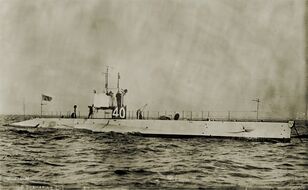S-1 and S-18 through S-29: Difference between revisions
Pbcjohnston (talk | contribs) Added start of individual boats section |
No edit summary |
||
| Line 1: | Line 1: | ||
==S-1 (SS-105)== | ==S-1 (SS-105)== | ||
[[File:Red bar sub.jpg]] | |||
[[File:L1-ussl11-01.jpg|thumb|frame|308x308px|left|Photo from the Library of Congress Collection.]] | [[File:L1-ussl11-01.jpg|thumb|frame|308x308px|left|Photo from the Library of Congress Collection.]] | ||
<p align="justify"><font color="#000066"> | <p align="justify"><font color="#000066"> | ||
| Line 15: | Line 15: | ||
==S-18 (SS-123)== | ==S-18 (SS-123)== | ||
[[File:Red bar sub.jpg]] | |||
[[File:L 2.jpg|left|thumb|U.S. Navy photo.]] | [[File:L 2.jpg|left|thumb|U.S. Navy photo.]] | ||
| Line 22: | Line 22: | ||
<p>[[S-18|See More S-18 photos]] | <p>[[S-18|See More S-18 photos]] | ||
[[File:Red bar sub.jpg]] | |||
Revision as of 20:35, 27 April 2023
S-1 (SS-105)

L-1 riding at anchor while on sea trials, March or April 1916, probably off Provincetown, Mass. A low-lying shore line with houses can be seen in the background, reminiscent of Cape Cod. The L-class were the first US submarines designed to carry a deck gun of any sort, in this case a 3"/23 caliber Mk 9 gun. But it wasn't until the L-9 that guns were installed during construction. The L-1 through L-8 were retrofitted later with the gun. As you can see the L-1 has no gun in this early photo.
S-18 (SS-123)

L-2 in an unknown location, approximately fall of 1916. In July of 1918 while patrolling in the Irish Sea, a large explosion rocked the L-2 about 25 feet on her beam. A torpedo aimed at her by a German U-boat had seemingly detonated prematurely. A periscope was sighted so the L-2 immediately submerged and made an unsuccessful attempt to ram the submarine. with her primitive sonar she couldn't track the U-boat well under water, plus the U-boat had superior under water speed. Later it was suspected that a U-boat had indeed attempted to fire upon the L-2, but another U-boat, the U-65, was unknowingly in the way and was hit by the torpedo meant for L-2. Some time later when the L-2 was dry docked her hull plating was noted to be heavily dented from the close by explosion. The U-65 never returned to her port.